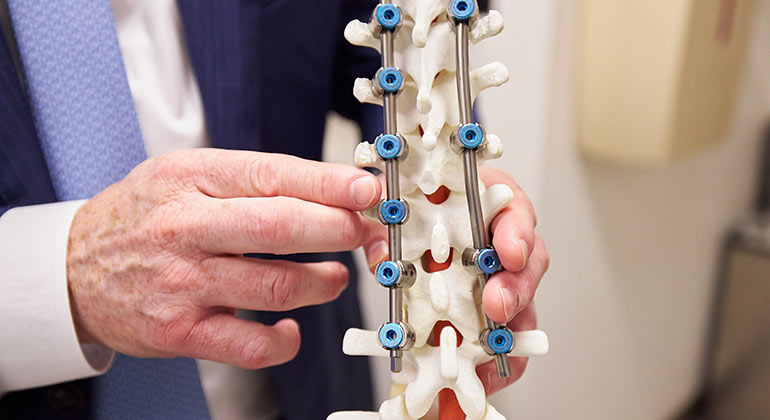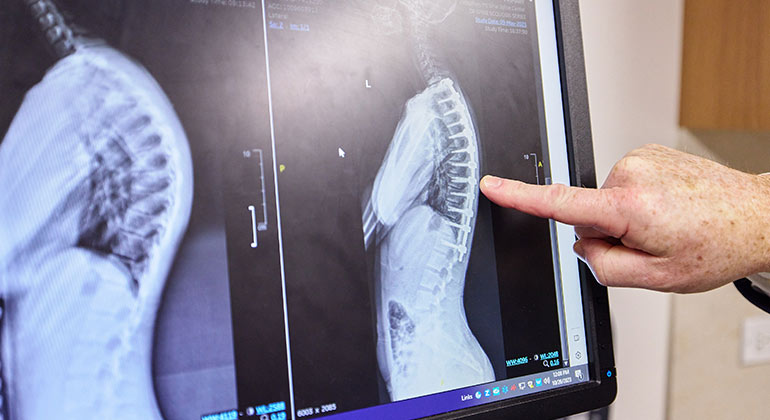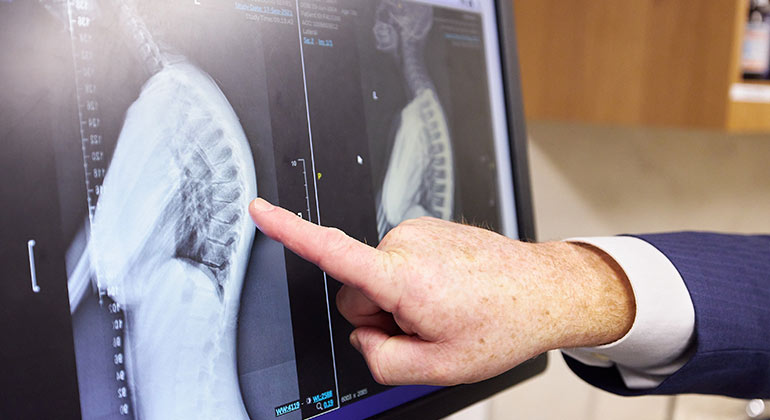Kyphosis



Some front-to-back spine curve is normal. But if your child has a “hunchback” appearance—an abnormally rounded upper back—it may be kyphosis. This orthopedic condition causes the spine to curve abnormally. Some children are born with kyphosis (called congenital kyphosis), but it usually develops during adolescence. Most cases of adolescent kyphosis are mild. Kyphosis is more common in girls than boys.
Most children with kyphosis don’t have any other symptoms. But if the condition becomes worse, it can be painful. Advanced kyphosis can make it hard to swallow or even breathe. That’s why it’s useful to have an orthopedist monitor your child’s spine until they stop growing, to see if it is progressing.
Other signs of mild kyphosis include:
- Upper back looks higher than normal when child bends over
- Head is almost always (or always) bent forward
- Excessively rounded shoulders
- Difference in the height or position of the shoulders or shoulder blades
If your child has a more severe case of kyphosis, you may see:
- Muscle tightness in the back of the thighs (hamstrings)
- Back pain or stiffness
- Extreme fatigue
- Difficulty breathing
Causes of Kyphosis
Often, we do not know what causes kyphosis. For this reason, it’s hard to know how to prevent the condition. But some cases are caused by:
- Cerebral palsy
- Muscular dystrophy
- Osteogenesis imperfecta
- Scheuermann’s kyphosis, which runs in families
- Spina bifida
- Spinal infections or tumors that weaken the spine
- Treatments for spinal tumors such as chemotherapy, radiation, and surgery
Some things can increase the chances that a child will develop kyphosis, including:
- Certain metabolic conditions such as diabetes
- Family history of spine problems
- Infections such as osteonmyelitis
- Poor posture (slouching)
- Spinal fracture that goes untreated or heals poorly
- Spinal tumors, either benign or malignant
You can get kyphosis in several locations: neck (called cervical kyphosis), thyroid (called Scheuermann’s disease) or lower back (called lumbar kyphosis).
Diagnosis
In early stages, kyphosis doesn’t usually cause pain. It is usually parents, school nurses, or pediatricians who typically notice that something is off. It is important to diagnose kyphosis early, for the most successful treatment. Typically, orthopedists start by doing a physical exam and taking a family and medical history. They will also measure the spinal curve. They might also use diagnostic tests such as:
- X-ray to measure the spinal curve
- Computerized tomography scan for a more detailed view of the spine
- Magnetic resonance imaging to identify or rule out spinal cord and nerve issues
- Bone scan to pinpoint any degenerative or arthritic conditions, check for bone diseases and tumors, rule out infection or fractures, and help determine the cause of bone pain or inflammation
Rarely, doctors may also perform blood or lung function tests.
Treatments We Offer
The goals for treating kyphosis are to stop the condition from getting worse and to correct spinal deformities in those who have reached their full height. Typically, we can treat kyphosis:
- Observation and monitoring
- Exercise
- Physical therapy
- Anti-inflammatory medicine
- Bracing to improve posture and correct curves
Surgery, which can be spinal fusion or vertebral body tethering